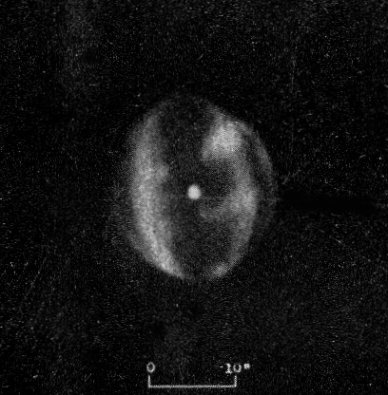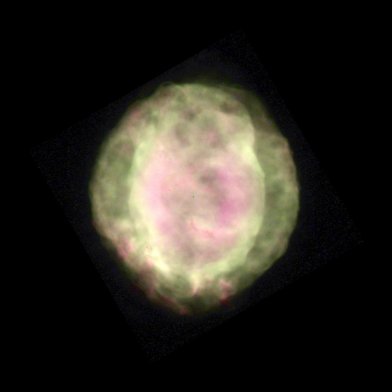NGC 6818
"A rather irregular oval ring...fainter along and at the ends of
the major axis...a fainter narrow ring...outside of the inner
bright ring. Fairly bright..." [Curtis]. NGC 6818 (the "Little Gem
Nebula") falls in busy,
but not overcrowded, far northeastern Sagittarius,
outside the visual confines of the Milky Way 8.5 degrees due west
of the line connecting Alpha and Beta Capricorni. Compact and
elliptically-shaped, the nebula measures 15" X 22" in diameter, which, given a
very approximate distance of 6500 light years, translates into a
physical size of 0.5 X 0.7 light years. Closely surrounding the
bright inner ring is a more-circular outer ring, a common sight
among such nebulae. Curtis's drawing captures the structure well,
including some of the detail seen in the Hubble image.
NGC 6818 is dimmed by about 0.6 magnitudes by interstellar dust
absorption. Chemical compositions are more or less normal, though
there may be some carbon enrichment. The central star is
anomalous. Curtis shows it prominently and gives it a visual
magnitude of 14, while it is only barely visible in the Hubble
image, various measures indicating around 17.0. It seems unlikely
that the star would fade three magnitudes over a mere century.
Perhaps Curtis saw a nebular clump instead, though there is no
indication of such by Hubble. With a temperature as high as
155,000 Kelvin and a luminosity estimated between 1000 and 2000
Suns, the relatively low mass central star (about 0.6 Suns, very
typical and consistent with normal chemical abundances) seems to be
near its maximum temperature, after which it will cool and dim to
become a common sort of white
dwarf.
Left: Image by H. D. Curtis from Publications of the Lick
Observatory, Volume 13, Part III, 1918. Right: R. Rubin (NASA Ames
Res. Cntr.), R. Dufour and M. Browning (Rice U.), P. Harrington (U.
Maryland), and NASA.



